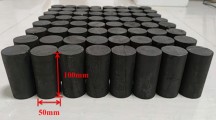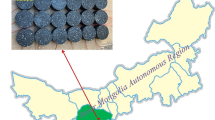Conclusions
-
1.
The existing methods of calculation of the coal excavation performance of hydraulic giants lack an adequate scientific basis. The destructibility criteria used, either are incapable in principle of describing the true properties of coal (Ry) or reflect the specifics of hydraulic destruction to a limited extent and characterize the interaction of the jet with the coal mass incompletely (ψ0).
-
2.
Attempts at developing a general criterion of coal destructibility by a hydraulic jet, as well as a phenomenological theory of strength, have been unsuccessful because of the extreme complexity of the phenomena and the large number of factors of different nature contributing to them.
-
3.
It is necessary to study the interaction of the jet with the coal mass to determine the patterns of the process and develop a scientific basis for hydraulic mining.
-
4.
The most promising trend of research is the development of continuous theory of defect accumulation and the theory of macrocracks. For practical purposes, it is desitable to develop a method for calculating the parameters of hydraulic excavation for given basic conditions.
Similar content being viewed by others
Literature Cited
Provisional Institructions on Calculation of the Productivity of Hydromonitor Coal Mining, [in Russian], Izd. VNIIGidrougol', Novokuznetsk (1983).
S. S. Shavlovskii, The Principles of Jet Dynamics in the Destruction of a Rock Mass [in Russian], Nauka, Moscow (1979).
N. F. Tsyapko, “Automation of high-pressure hydraulic breaking of coal,” in: Transactions of the Institute of Hydraulic Coal Mining [in Russian], Vol. 1, Novokuznetsk (1962).
V. M. Sukharevskii, “Testing high-pressure hydromonitor jets,” Ugol', No. 9 (1940).
G. P. Nikonov, I. G. Ishchuk, I. A. Kuz'mich, and G. I. Kuznetsov, Intensification of Hydraulic Breaking of Coal in Donbass Mines [in Russian], Nedra, Moscow (1964).
A. P. Filin, Applied Mechanics of Deformable Solids [in Russian], Vol. 1, Nauka, Moscow (1975).
N. F. Tsyapko, “Theoretical aspects of hydraulic coal mining,” in: Problems of Hydraulic Coal Mining [in Russian], Novokuznetsk (1968) (Transactions of the Institute of Hydraulic Coal Mining, Vol. 12 (suppl.)).
E. A. Sigaev, “A study of the hydraulic breaking process for development workings,” Izv. Vyssh. Uchebn. Zaved., Gornyi Zh., No. 10 (1958).
B. A. Teodorovich, N. F. Tsyapko, and Yu. B. Geft, A Method for Calculating the Performance of Hydromonitors from Basic Hydraulic Excavation Output [in Russian], No. 6, VNIIGidrougol'., Novokuznetsk (1969).
V. V. Bolotin, Statistical Methods in Construction Mechanics [in Russian], Stroiizdat, Moscow (1961).
E. I. Il'nitskaya, R. I. Teder, E. S. Vatolin, and M. F. Kuntysh, Properties of Rocks and Methods of their Determination [in Russian], Nedra, Moscow (1969).
Additional information
Institute of Coal, Siberian Branch, Academy of Sciences of the USSR, Kemerovo. Translated from Fiziko-Tekhnicheskie Problemy Razrabotki Poleznykh Iskopaemykh, No. 2, pp. 80–85, March–April, 1986.
Rights and permissions
About this article
Cite this article
Sigaev, E.A., Teodorovich, B.A. Current state and development trends in the theory of hydraulic coal excavation. Soviet Mining Science 22, 147–151 (1986). https://doi.org/10.1007/BF02500806
Received:
Issue Date:
DOI: https://doi.org/10.1007/BF02500806




